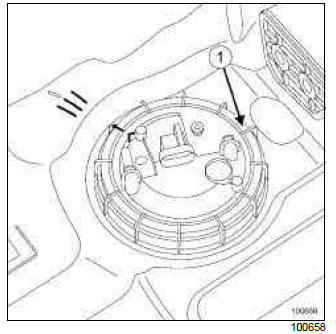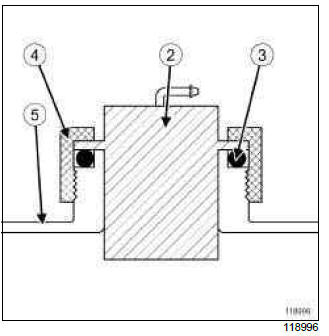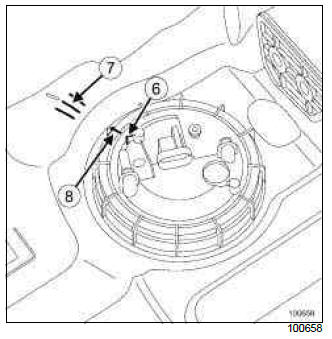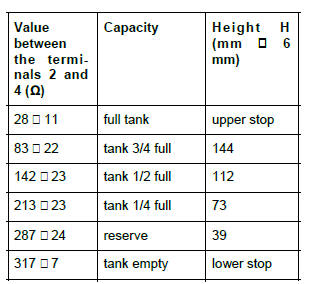Renault Clio: Pump - sender - filter: Removal - Refitting
D4F or F4R or K4J or K4M or M4R

IMPORTANT
During this operation, be sure to:
- be careful of fuel splashes when disconnecting the union.
IMPORTANT
Wear goggles with side protectors for this operation.
IMPORTANT
Wear latex gloves during the operation.
WARNING
To prevent impurities from entering the circuit, plugs must be fitted to the openings of all the fuel circuit components exposed to the open air.
WARNING
To avoid any corrosion or damage, protect the areas on which fuel is likely to run.
REMOVAL
I - REMOVAL PREPARATION OPERATION
- Position the vehicle on a two-post lift (see Vehicle: Towing and lifting) (MR 392, 02A, Lifting equipment).
- Disconnect the battery (see ) (MR 392, 80A, Battery).
- Drain the fuel tank (see 19C, Tank, Fuel tank: Draining, 19C-8).
- Remove the fuel tank (see 19C, Tank, Fuel tank: Removal - Refitting, 19C-1).
II - OPERATION FOR REMOVAL OF PART CONCERNED

- Remove the nut (1) from the fuel sender module using the (Mot. 1397).
Note: Take care to ensure that the float is not damaged during the operation.
- Remove the fuel sender module, preparing for the flow of fuel.
WARNING
In order to avoid any damage to the tank, refit the " pump-sender-filter " assembly nut as soon as the assembly is removed.
REFITTING
I - REFITTING PREPARATIONS OPERATION
- Always replace:
- the fuel sender module nut,
- the O-ring seal.
II - REFITTING OPERATION FOR PART CONCERNED
- Refit the fuel sender module.

- Correctly position the seal (3) in the neck.
- Position the fuel sender module (2) on the tank (5) ; a lug on the fuel sender module and a recess in the tank ensure correct fitting in the tank.
- Press on the "fuel sender" module to secure the seal, manually pre-tighten the "fuel sender" module nut (4) on the tank.

- Tighten the fuel sender module nut using the (Mot.1397) until the index (8) corresponds with the tank index (7) and the "fuel sender" module index (6).
III - FINAL OPERATION.
- Refit the fuel tank (see 19C, Tank, Fuel tank: Removal - Refitting, 19C-1).
- Connect the battery (see ) (MR 392, 80A, Battery).
- Check that there are no fuel leaks:
- run the engine at idle speed,
- accelerate several times at no load,
- switch off the ignition,
- check that there is no fuel escaping.
Fuel level sensor: Check
D4F or K4J or K4M or M4R

Check that the resistance varies when the float is moved.
Place the sender unit on a flat surface.
H is the height between the sender unit float pivot and the flat surface.
K9K

Check that the resistance varies when the float is moved.
Place the sender unit on a flat surface.
H is the height between the sender unit float pivot and the flat surface.

